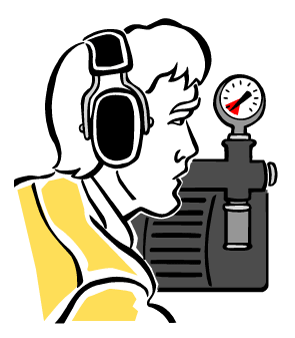“Short on Fuel, Long on Luck”

ASRS receives many reports of General Aviation fuel exhaustion incidents that lead to inflight emergencies or off-airport landings. Thanks to the skill and luck of the involved pilots, most of these landings are described as “uneventful,” without damage to the aircraft or injury to the aircraft’s occupants. While there are many ways to run the tanks dry, recent ASRS reports have focused on several causal factors – recalibrated dipsticks, inaccurate fuel burn data, and preflight inspections and flight planning that are delegated to other persons.
Duped by the Dipstick
A dipstick gave dubious readings during preflight, but this instructor pilot, whose voice of “better judgement” was sidetracked, let another pilot check fuel quantities.
-
…The aircraft held five hours of fuel and the time en-route was to be four hours. Along the route we experienced some greater than planned head winds which slowed our ground speed. After some in-flight computations, we determined that we still had adequate fuel to make it to our destination with reserves…We were still under IFR but in VMC when we began the approach with radar vectors from Center. Approximately 15 miles from the airport, the engine began to sputter and stopped producing power. We notified Center and informed them that we were going to set it down on a road. The landing was uneventful and no damage occurred to the aircraft or property.
Contributing factors to the event were the use of carburetor heat during the flight, which after the fact was determined to use more fuel. The greater than planned winds and the less than minimum landing ceilings along the route preventing a closer fuel stop were all factors. Another factor had to do with the calibration of the fuel dipstick, in that it was recently recalibrated to a greater quantity than I thought was in the fuel tank. I went against my better judgement and used what was said on the stick. Finally, since I was with a private pilot who was doing most of the flying, I allowed him to perform the preflight on the aircraft and check fuel quantities. I did not double-check his preflight…I should have gone with my better judgement and…performed my own preflight.
Fooled by the Fuel Burn
A Citabria pilot experienced a surging engine and altitude loss eight miles from the destination airport. The pilot conducted a safe landing in a suitable field, with no damage to the aircraft or injuries. The ASRS report narrative continues:
-
...The planned flight time was 3.2 hours. There were 24 gallons of usable fuel on board. Expected fuel burn was 4.8 GPH. There should have been enough fuel for 5 hours. The fuel was exhausted after 3.7 hours…Fuel burn data was established a year and a half previously when using aggressive leaning at all times, and at relatively low power settings. Three weeks prior to the flight in question, the A&P mechanic performing the annual inspection advised the pilot that excessive leaning was harmful to the engine and suggested that it should not be leaned unless above 5,000 feet MSL. The flight in question was conducted at 5,000 feet MSL. In addition, the pilot began using higher power settings, believing this was desirable for this engine….
This experience demonstrates…the importance of ensuring that the data used for planning, in this case fuel burn data based on specific leaning and power settings, applies to the operation being undertaken.
Unfamiliar with Fuel Requirements

This flyer was lucky enough to make an airport when the left engine quit from fuel exhaustion. In looking back on the incident, the pilot noted, “Many factors contributed to this incident, but the bottom line is that I got lazy and made a bad decision”:
-
I was near the end of a trip that included many legs and required a fuel purchase. I knew that my fuel was going to be tight, but I honestly thought I would land with the required reserve. As I was being vectored and descending for the airport, my left engine began to surge and the fuel pressure light illuminated. I was less than 5 minutes from landing. I declared an emergency and landed without incident at another airport that was right in front of me. The left engine had quit by the time I landed. Factors that contributed: (1) Someone else did the flight planning (fuel calculations) before I left because it was a last-minute flight. Therefore I wasn’t as familiar with the required fuel as I should have been. (2) I got lazy with my leaning procedures, using previous settings or not leaning at all for a few short legs. (3) I believed the fuel gauges, which indicated that I had much more fuel than I actually did. (4) At my last stop, I asked the FBO for some fuel (“comfort fuel”) but their truck was out of service. So instead of going through the hassle of taxiing to another FBO, I…decided to go with what I had…Never again!
“Minimum Fuel” Does Not Mean 
Priority Handling
Recent ASRS incident reports reveal a common misunderstanding involving use of the phrase “minimum fuel.” Pilots may tell ATC that they have “minimum fuel” with the expectation that they will receive priority handling. However, ATC is under no obligation to provide priority handling unless the pilot declares a fuel “emergency.” The AIM (section 5-5-15) provides further clarification:
-
Advise ATC of your minimum fuel status when your fuel supply has reached a state where, upon reaching destination, you cannot accept any undue delay.
-
Be aware that this is not an emergency situation, but merely an advisory….
-
Be aware [that] a minimum fuel advisory does not imply a need for traffic priority.
-
If the remaining usable fuel supply suggests the need for traffic priority to ensure a safe landing, you should declare an emergency due to low fuel and report fuel remaining in minutes.
Controllers have several responsibilities when advised of a “minimum fuel” situation – they must relay this information to the ATC facility to which control jurisdiction is transferred; and be alert for any occurrence that might delay the aircraft. Controllers are also encouraged to use “common sense and good judgement [to] determine the extent of assistance to be given in minimum fuel situations.” (Order 7110.65, Air Traffic Control)
A report from an MD-80 Captain describes a “minimum fuel” situation and shows how ATC used its judgement to declare an emergency when the flight crew was reluctant to use the “E” word. (Editor’s note: See CALLBACK #310 for a fuller discussion of emergency declarations.)
- Flt from ZZZ to ZZZ1. No alternate fuel required and dispatched with approximately 25 minutes of holding fuel. Approaching fix, we were given a clearance to do two 360 degree turns. Following that clearance, we were given direct ZZZ2 VOR and 2 more turns in holding. Released from that fix to next fix and the arrival. Approaching intersection, we were told to hold again with an EFC of approximately 30 minutes. After one turn in holding, told them we were unable to hold and requested divert to ZZZ3. After being given a heading away from the field, I declared minimum fuel. After still being given the vector away from the field, I restated to the controller that I was minimum fuel. Was then given vectors to another arrival…I was told we were 15 in line for Runway 31R and I again informed the controller we were minimum fuel. He said that unless we were a fuel emergency we were still 15 in line. The Approach Controller ultimately declared us as an emergency and then gave us clearance for a visual to Runway 31L…Ultimately, we landed with approximately 4 minutes of fuel before we were in an emergency fuel status.
Have You Got Enough?
A number of ASRS air carrier reporters involved in “minimum fuel” incidents observe that today’s tight fuel plans leave pilots few options for extending their flights:
- I have noticed that many dispatchers supply us with adequate fuel for flights with no room for vectors, being held down or other problems. The higher passenger weights have brought in a problem of trying to maximize passengers against a conservative fuel plan.
- Lesson learned: planning a flight to busy cities on minimum fuel requires a lot of things to go right, i.e., no departure delays, smooth flight planned altitudes, and no arrival delays – even in perfect weather.
- This flight fit the trend of next-generation flight plans with long, direct legs between fixes and strong winds aloft. The flight planning program apparently makes assumptions about the wind model between waypoints and comes up with an unrealistically low fuel burn. This problem does not appear on more traditional routings with shorter legs between checkpoints because there are more fixes to accurately account for the wind. Lesson learned: an extra 1000-1500 lbs. [of fuel] over what we had would have given us the fuel to deal with the winds aloft and developing weather and reach our destination without receiving traffic priority.
Meet
the Staff
Continuing the staff introductions initiated in previous issues of CALLBACK, this month we feature…
Edward C. (Ed) Arri

Ed Arri first joined the ASRS staff in 1989, and has held a number of key analyst positions. From 1989-1999 he was Chief Analyst, responsible for all screening, analysis, and quality control of the ASRS reporting process. In addition to analyzing aviation incident reports, Ed has also specialized in air traffic analyses to support FAA procedures design, rule-making, and Quick Response studies.
Prior to joining the ASRS staff, Ed was a manager, supervisor, and air traffic controller with the FAA and Air Force for more than 37 years. He served at the San Francisco Bay TRACON, the Monterey, CA, Tower/TRACON, and the Reno, NV, Tower/TRACON.
When not at the office, Ed has been working on his golf game and is seriously considering changing to Ping-Pong.
|




